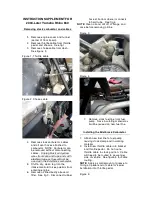
Regenerative Braking System
This feature is used to simulate the engine braking of an internal
combustion engine and assist the standard brake system while recovering
some of the energy of motion and storing it in the battery to improve fuel
economy. The standard brake system is designed to fully stop the car if
regenerative braking is not available. During regenerative braking, the
motor is spun as a generator to create electrical current. This recharges
the battery and slows the vehicle. In effect, once the accelerator pedal is
released, the motor changes from an energy user to an energy producer.
When the accelerator pedal is released or the brake pedal is applied,
the brake controller automatically detects the amount of deceleration
requested and optimizes how much of the deceleration will be produced
by regenerative braking. The remaining portion is generated by standard
friction braking. When the battery is almost fully charged, the amount of
regenerative braking is limited to avoid overcharging, and the requested
deceleration is produced by standard friction braking alone.
Regenerative braking does not take the place of the standard friction
brakes; it only assists them. Regenerative braking has also been designed
to interact with the anti-lock brake system. Regenerative braking is
disabled when the anti-lock brake system is activated or the battery is
fully charged.
HINTS ON DRIVING WITH ANTI-LOCK BRAKES
When the system is operating, the brake pedal will pulse and may travel
further. Maintain pressure on the brake pedal. You may also hear a noise
from the system. This is normal.
The anti-lock braking system will not eliminate the dangers inherent when:
•
you drive too closely to the vehicle in front of you.
•
your vehicle is hydroplaning.
•
you take corners too fast.
•
the road surface is poor.
Brakes
219
2013 C-Max Full Hybrid
(34h)
Owners Guide gf, 3rd Printing, January 2013
USA
(fus)
















































